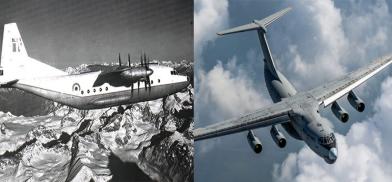Little known heroes of Indian Air Force's 44 Squadron: 50 years of crucial airlifts
During the Indian Peace Keeping Force (IPKF) operations in Sri Lanka, 44 Squadron played a crucial role in transporting men and material, including T-72 tanks and artillery guns, in the early hours of 30 July 1987, greatly contributing to the airlift effort.

44 Squadron of the Indian Air Force (IAF) which is known for the vital task of strategic lifts, is celebrating its Diamond Jubilee in 2023 year at Chandigarh. The rich and glorious history of this Squadron is a kaleidoscope of military history, which is an important part of the nation’s history, and military diplomacy, which is an inseparable and often visible part of the country’s diplomacy. The Squadron’s half a century of existence is replete with tales of fortitude, courage, daring, devotion and professionalism which encompasses all that IAF stands for and strives for.
Raised on 06 April 1961, the Squadron flew its first sortie to Chushul on 9th April 1961 in support of the Army, a year and a half before China’s first aggression into India in 1962. Its first aircraft was the Antonov (AN)-12, a great workhorse manufactured by the USSR (United Soviet of Socialist Republics) which the Squadron operated till 1985. In March 1985, it brought the Ilyushin (IL)-76 aircraft into India, which was formally inducted into IAF on 16 Jun 1985 and continues to be in service currently. The Diamond Jubilee celebrations due in 2021 had to be postponed due to the COVID-19 pandemic.
The harbinger of strategic airlift in the IAF, the Squadron has been a part of all major military and HADR (humanitarian assistance and disaster relief) initiatives in the recent history of the nation, which not only saw the IAF and the nation evolve from a tactical to a strategic force, but also enhanced the military might of the Army and the Navy. The Squadron provided succor in times of need to not only citizens of India but also to people from counties all around the world. Its operations have also included transportation of troops by air and air-drop of troops, equipment, supplies, and very importantly, support or augmentation of special operations forces, whenever considered necessary.
Having undertaken extensive air maintenance sorties in the Ladakh and Jammu & Kashmir sectors, the Squadron was awarded the emblem of "Himalayan Geese" on 26 May 1966 by the then President, Sarvepalli Radhakrishnan .
Logistical support providers to the frontliners
While the IAF was not used in an offensive role in 1962 as the government did not even think about it, in 1965 it participated in the war. In the 1971 India-Pakistan War, the Squadron proved its mettle by innovating and effectively employing AN-12s in the bombing role in the Western theatre. Notably, 44 Squadron is the only transport squadron of the Indian Air Force to be conferred Battle Honours, usually accorded to active operational combat units.
During the 1962 operations, the 44 Squadron provided logistic support to the Indian Army in the Ladakh sector, landing sorties at Leh and Chushul, airdrop of supplies to various forward posts in the Aksai Chin area, and evacuation of a large number of casualties. In the 1971 operations, the 44 Squadron effectively used AN-12s for bombing missions and undertook the first mission to the Changa Manga forest ammunition depot on the very first day. It was awarded the ‘’Battle Honours’ for the 1971 operations, making it the only non-fighter/bomber squadron in the IAF to receive this distinction.
During the Indian Peace Keeping Force (IPKF) operations in Sri Lanka, 44 Squadron played a crucial role in transporting men and material, including T-72 tanks and artillery guns, in the early hours of 30 July 1987, greatly contributing to the airlift effort. The squadron flew extensively during the IPKF operations, which culminated in March 1990.
In recent years, 44 Squadron has continued to serve the nation with distinction. During the ongoing operations in Eastern Ladakh, it airlifted more than 2,000 troops to the Ladakh sector besides all kinds of equipment. After the induction of the IL-76 aircraft in 1985, the squadron carried out practice landings at Thoise in October 1985 and in early 1986, inducted tanks and artillery guns into the Ladakh region. This aircraft has been the mainstay of the induction of battle tanks and other large equipment.
(The author, a strategic analyst and former spokesperson, Defence Ministry and Indian Army, can be contacted at wordsword02@gmail.com)










Post a Comment